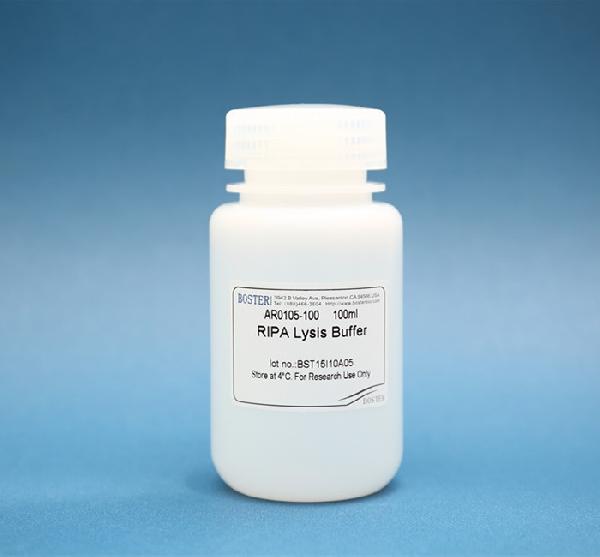
RIPA Lysis Buffer
AR0105-100
Product group Chemicals
Overview
- SupplierBoster Bio
- Product NameRIPA Lysis Buffer
- Delivery Days Customer9
- CertificationResearch Use Only
- Scientific DescriptionRIPA Lysis Buffer is a complete cell lysis solution reagent used for rapid and efficient total cell lysis and solubilization of proteins from both adherent and suspension cultured mammalian cells, effectively extracting cytoplasmic, nuclear and membrane proteins. RIPA lysis buffer is highly compatible with various downstream protein analysis applications.
- Storage Instruction2°C to 8°C
- UNSPSC12161700
References
- Ji H, Zhang Z, Chen C, et al. The impact of quercetin and paclitaxel combination on ovarian cancer cells. iScience. 2024,27(8):110434. doi: 10.1016/j.isci.2024.110434Read this paper
- Yang J, Qin S, Sun N, et al. Neohesperidin alleviates the inhibitory effect of bisphenol A on the myogenic differentiation of umbilical cord mesenchymal stem cells via the IGF1R/AKT1/RHOA signaling pathway. Ecotoxicol Environ Saf. 2024,283:116804. doi: 10.1016/j.ecoenv.2024.116804Read this paper
- Ma F, Yao J, Niu X, et al. MARK4 promotes the malignant phenotype of gastric cancer through the MAPK/ERK signaling pathway. Pathol Res Pract. 2024,261:155471. doi: 10.1016/j.prp.2024.155471Read this paper
- Quan Y, Yu X. The Cytotoxic Effects of Human Mesenchymal Stem Cells Induced by Uranium. Biology (Basel). 2024,13(7). doi: 10.3390/biology13070525Read this paper
- Lu R, Qu Y, Wang Z, et al. TBK1 pharmacological inhibition mitigates osteoarthritis through attenuating inflammation and cellular senescence in chondrocytes. J Orthop Translat. 2024,47:207-222. doi: 10.1016/j.jot.2024.06.001Read this paper
- Zhu W, Zhang Q, Jin L, et al. OTUD1 Deficiency Alleviates LPS-Induced Acute Lung Injury in Mice by Reducing Inflammatory Response. Inflammation. 2025,48(2):649-661. doi: 10.1007/s10753-024-02074-7Read this paper
- Gan Y, Zhang X, Cai P, et al. The Role of Oxidative Stress and DNA Hydroxymethylation in the Pathogenesis of Benzo[a]pyrene-Impaired Reproductive Function in Male Mice. Environ Toxicol. 2024,39(11):5039-5047. doi: 10.1002/tox.24384Read this paper
- Zhu J, Cheng W, He TT, et al. Exploring the Anti-Inflammatory Effect of Tryptanthrin by Regulating TLR4/MyD88/ROS/NF-κB, JAK/STAT3, and Keap1/Nrf2 Signaling Pathways. ACS Omega. 2024,9(28):30904-30918. doi: 10.1021/acsomega.4c03795Read this paper
- Meng X, Liu J, Kang J, et al. Lamivudine protects mice from gastric ulcer by activating PGK1 to suppress ferroptosis. Biochem Pharmacol. 2024,227:116440. doi: 10.1016/j.bcp.2024.116440Read this paper
- Hao EJ, Zhao Y, Yu M, et al. Discovery, Synthesis, and Activity Evaluation of Novel Five-Membered Sulfur-Containing Heterocyclic Nucleosides as Potential Anticancer Agents In Vitro and In Vivo. J Med Chem. 2024,67(15):12553-12570. doi: 10.1021/acs.jmedchem.4c00443Read this paper
